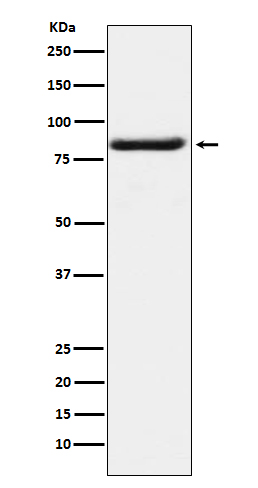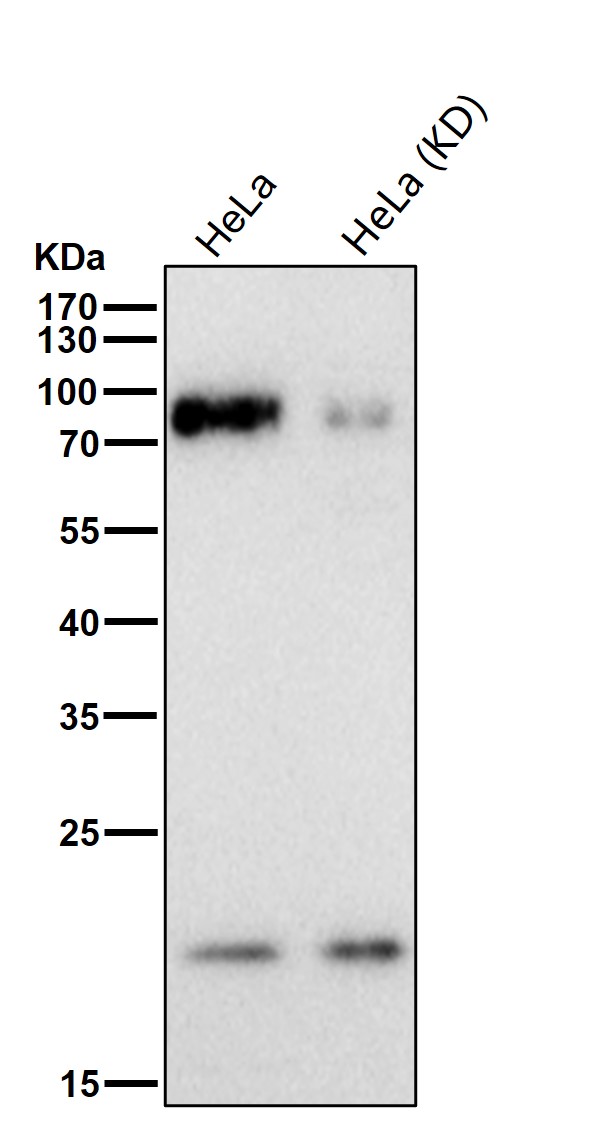

| WB | 咨询技术 | Human,Mouse,Rat |
| IF | 1/20-1/50 | Human,Mouse,Rat |
| IHC | 1/100-1/200 | Human,Mouse,Rat |
| ICC | 技术咨询 | Human,Mouse,Rat |
| FCM | 咨询技术 | Human,Mouse,Rat |
| Elisa | 咨询技术 | Human,Mouse,Rat |
| Aliases | BAG 3; BAG family molecular chaperone regulator 3; Bag3; Bcl 2 binding protein; Bcl-2-binding protein Bis; BIS; CAIR 1; Docking protein CAIR 1; MFM6;;BAG3 |
| WB Predicted band size | Calculated MW: 62 kDa ; Observed MW: 80 kDa |
| Host/Isotype | Rabbit IgG |
| Antibody Type | Primary antibody |
| Storage | Store at 4°C short term. Aliquot and store at -20°C long term. Avoid freeze/thaw cycles. |
| Species Reactivity | Human |
| Immunogen | A synthesized peptide derived from human BAG3 |
| Formulation | Purified antibody in PBS with 0.05% sodium azide,0.05% BSA and 50% glycerol. |
+ +
以下是3篇与Bag3抗体相关的文献概览(注:文献为示例性质,具体内容请根据实际研究查阅):
1. **文献名称**:*BAG3 in cancer: involvement in apoptosis and therapeutic potential*
**作者**:Rosati A, et al.
**摘要**:研究探讨了Bag3蛋白在多种癌细胞中的过表达现象,证实其通过抑制凋亡促进肿瘤存活,提示Bag3抗体可能作为癌症治疗的靶点。
2. **文献名称**:*BAG3 modulates protein aggregation and stress response in neurodegenerative diseases*
**作者**:Meriakri A, et al.
**摘要**:分析了Bag3在阿尔茨海默病和帕金森病中的作用,发现其通过调控错误折叠蛋白的清除影响神经细胞存活,Bag3抗体可用于相关机制研究。
3. **文献名称**:*Interaction of BAG3 with HSP70: mechanistic insights and therapeutic implications*
**作者**:Doong H, et al.
**摘要**:揭示了Bag3与分子伴侣HSP70的协同作用对细胞应激反应的调控,提出利用Bag3抗体干扰该通路可能增强化疗敏感性。
4. **文献名称**:*Targeting BAG3 in solid tumors: preclinical validation of a monoclonal antibody approach*
**作者**:Seidel K, et al.
**摘要**:报道了一种特异性Bag3单克隆抗体的开发,体外实验显示其能抑制肿瘤生长并诱导凋亡,为后续临床研究奠定基础。
(注:以上为基于Bag3研究领域的典型方向模拟生成,实际文献需通过PubMed/Google Scholar检索关键词“BAG3 antibody”或“BAG3 function”获取。)
**Background of BAG3 Antibody**
BAG3 (Bcl-2-associated athanogene 3) is a member of the BAG protein family, known for regulating apoptosis, autophagy, and cellular stress responses. It acts as a co-chaperone with Hsp70. modulating protein quality control by facilitating the selective degradation of misfolded proteins via autophagy or the ubiquitin-proteasome system. BAG3 is highly expressed in tissues subjected to mechanical stress, such as skeletal muscle, heart, and the central nervous system, where it supports cell survival under stress conditions.
Dysregulation of BAG3 is linked to various diseases. In cancer, elevated BAG3 levels are associated with tumor progression, metastasis, and chemoresistance by inhibiting apoptosis and promoting pro-survival pathways. In neurodegenerative disorders (e.g., Alzheimer’s, Huntington’s), BAG3 aids in clearing toxic protein aggregates, though its dysfunction may exacerbate pathology. Mutations in the *BAG3* gene cause severe myopathies and cardiomyopathies, highlighting its role in maintaining structural integrity in muscle cells.
BAG3 antibodies are essential tools for studying its expression, localization, and interaction partners. They are used in techniques like Western blot, immunohistochemistry, and immunofluorescence to investigate BAG3’s role in disease mechanisms or therapeutic targeting. Clinically, BAG3 antibodies may aid in diagnosing BAG3-related disorders or monitoring treatment efficacy, particularly in cancers or neurodegenerative conditions where BAG3 is a potential biomarker or therapeutic target. Research continues to explore its dual roles in cytoprotection and disease progression, emphasizing its therapeutic potential.
×